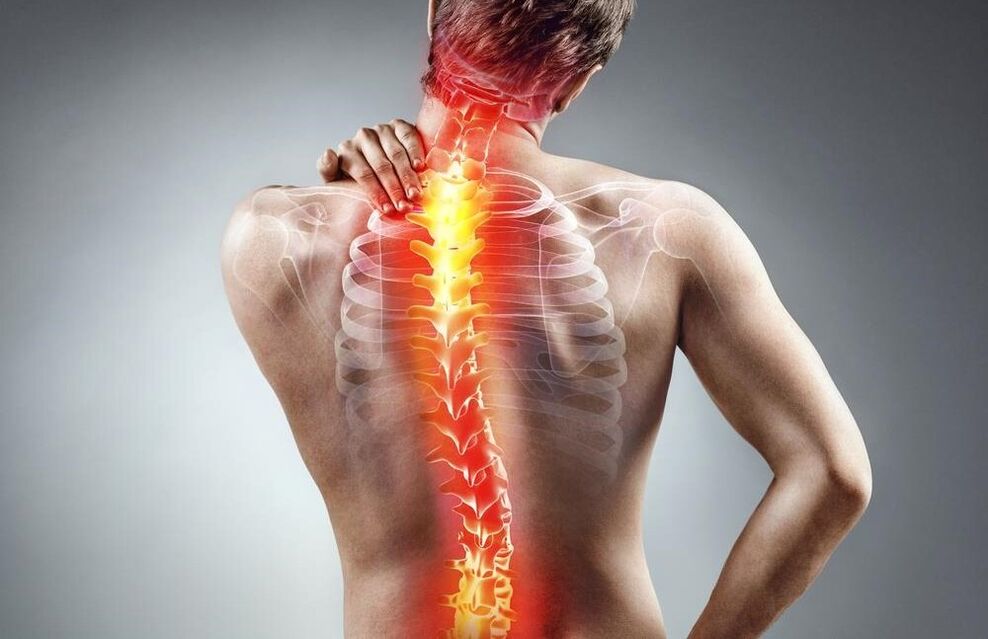An imbalance between physical and emotional stress, trauma and complications, hypothermia and colds contribute to the development of osteochondrosis. The pathology is caused by degenerative changes in cartilaginous segments and bone tissue. Increased mobility of the discs increases the probability of the process, which is confirmed by the statistics of the highest prevalence in the cervical and lumbar region. In addition to the spine, the joints of the upper and lower extremities are also affected.

Types and causes of osteochondrosis
Excessive overload of the spinal segments or joints, depending on the location and degree, is the main cause of osteochondrosis, which is divided into the following types:
- Osteochondrosis of the thoracic region is a pathological process of unclear etiology, however, according to clinical studies, it develops as a result of:
- hormonal disorders;
- improper posture;
- structural anomalies and curvatures;
- injuries sustained;
- occupational activity associated with stress or prolonged column vibration;
- flat feet;
- limitation of physical activity or reverse process due to physical overload;
- overweight.
- Cervical osteochondrosis is a pathology commonly referred to as "salt deposition". The main causes of cervical osteochondrosis lie in the increased activity of the neck and caused by malnutrition of the tissues in the background:
- excessive strain on the neck;
- hypothermia and previous colds;
- uncontrolled sports without respect for safety and security measures;
- unfavorable conditions for meteorological factors;
- stressful situations;
- prolonged sitting without changing posture;
- exposure to chemicals.
- Osteochondrosis dissecans or Koening's disease is a degenerative-dystrophic process that begins with dystrophy followed by inflammation of the knee, hip, elbow and clavicle-shoulder joints. Causes include:
- injuries sustained;
- hereditary predisposition;
- violation of the patency of a branch of an adjacent artery.
Pathological abnormalities cause irregular growth of bone tissue, movement of discs and joints and irritation of nerve roots, which is accompanied by pain.
Symptoms of the disease
The clinical picture, depending on the type of pathology, is different. In particular, shortness of breath occurs in thoracic spine osteochondrosis, caused by:
- pain that increases with breathing and restriction of movement in the chest area;
- intercostal neuralgia caused by irritation or damage to the spinal roots;
- secondary deformities in the thoracic region on the background of kyphoscoliosis and reduction in lung volume.
Due to the clinical picture, disguised as the symptomatology of other diseases, the pathological process is mistaken for angina pectoris, ischemia, pneumonia, gastroenterological disorders, which is why it is called "chameleon".
One of the common symptoms is dizziness in cervical osteochondrosis, which occurs due to compression of blood vessels and impaired cerebral circulation, with insufficient oxygen and nutrients entering the brain. The pathology is manifested by additional symptoms:
- loss of orientation in space;
- noise in the head and ears;
- darkening of the eyes or flickering spots;
- throbbing headache;
- nausea and vomiting.
If you feel limited tongue movements and staggering while walking, seek emergency medical help and lie face down before the patient arrives.
The symptoms of Koening's disease are determined by the stage of the process, ranging from discomfort and rapid fatigue of the affected limb to pain that grows over time and an increase in the volume of the joint, visible visually.
Therapeutic activities
Treatment of the disease requires an integrated approach, divided into periods. In the acute phase, drug therapy is prescribed, physiotherapy methods and folk remedies are additionally used. Recovery in resorts is recommended during the period of remission, but it should be borne in mind that spa treatment of osteochondrosis during exacerbation will not only not be useful, but can also be harmful.
Drug treatment
In the acute stages of osteochondrosis, drugs are prescribed orally:
- anti-inflammatory drugs to eliminate the inflammatory process;
- analgesics for pain relief;
- muscle relaxants to relieve muscle cramps;
- anticonvulsants to remove compression of nerve endings;
- chondroprotectors for cartilage tissue regeneration;
- sedatives to relieve stress and support the nervous system;
- vitamin complexes to provide the body with the necessary nutrients and general strengthening.
Therapeutic blockades by injection directly into the affected area are used to relieve pain. The analgesic effect and the improvement of local circulation are created by ointments and creams that are applied locally to the affected area.
Physiotherapy procedures
Physiotherapy is prescribed both in parallel with medication and during the period of remission in order to maintain a stable position and prevent recurrence. For medical purposes use:
- traction therapy and reflexology;
- acupuncture with electrical stimulation and exposure to cold;
- shopping and acupressure massage;
- ultrasonic and electromagnetic vibration therapy.
Procedures performed by a medical specialist improve blood circulation, restore functionality to damaged segments and increase vitality. Self-medication can cause relapse, lead to worsening and contribute to the development of pathology.



















